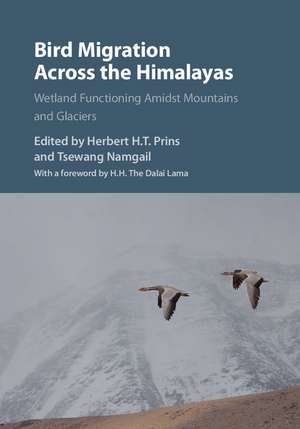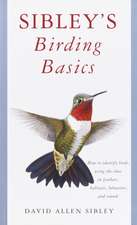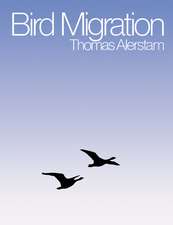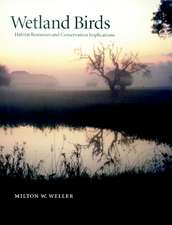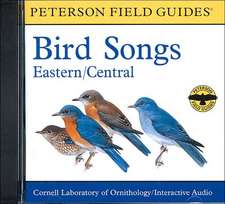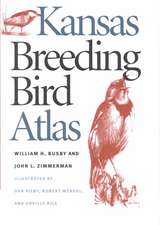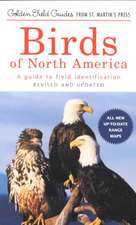Bird Migration across the Himalayas: Wetland Functioning amidst Mountains and Glaciers
Editat de Herbert H. T. Prins, Tsewang Namgail Cuvânt înainte de Dalai lamaen Limba Engleză Hardback – 5 apr 2017
Preț: 672.17 lei
Preț vechi: 755.24 lei
-11% Nou
Puncte Express: 1008
Preț estimativ în valută:
128.64€ • 133.80$ • 106.20£
128.64€ • 133.80$ • 106.20£
Carte tipărită la comandă
Livrare economică 15-29 aprilie
Preluare comenzi: 021 569.72.76
Specificații
ISBN-13: 9781107114715
ISBN-10: 1107114713
Pagini: 458
Ilustrații: 52 b/w illus. 110 colour illus. 35 maps 30 tables
Dimensiuni: 180 x 253 x 27 mm
Greutate: 1.12 kg
Editura: Cambridge University Press
Colecția Cambridge University Press
Locul publicării:New York, United States
ISBN-10: 1107114713
Pagini: 458
Ilustrații: 52 b/w illus. 110 colour illus. 35 maps 30 tables
Dimensiuni: 180 x 253 x 27 mm
Greutate: 1.12 kg
Editura: Cambridge University Press
Colecția Cambridge University Press
Locul publicării:New York, United States
Cuprins
Forward; Preface; Introduction; Part I. Migratory Routes and Movement Ecology: 1. Goose migration across the Himalayas: migratory routes and movement patterns of bar-headed geese; 2. Himalayan thoroughfare: migratory routes of ducks over the rooftop of the world; 3. Migratory routes across the Himalayas used by Demoiselle Cranes; 4. Passerine migration across the Himalayas; 5. Wader migration across the Himalayas; 6. Raptor migration across and around the Himalayas; 7. Steppe Eagle migration from Mongolia to India; 8. Peregrine Falcons crossing the 'Roof of the World'; Part II. Physiography of the Highest Barrier on Earth: 9. Geological origin and evolution of the Himalayas; 10. Late Quaternary glacier fluctuations in the Himalayas and adjacent mountains; 11. The influence of hydrology and glaciology on wetlands in the Himalayas; 12. The Himalayan vegetation along horizontal and vertical gradients; 13. Assessing the evidence for changes in vegetation phenology in high altitude wetlands of Ladakh (2002–2015); Part III. High-Altitude Migration Strategies: 14. The wind system in the Himalayas: from a bird's-eye view; 15. Birds, gliders and uplift systems over the Himalayas; 16. Goose migration over the Himalayas: physiological adaptations; 17. Distance-altitude trade off may explain why some migratory birds fly over and not around the Himalayas; 18. Refuelling stations for waterbirds: macroinvertebrate biomass in relation to altitude in the Trans-Himalayas; 19. The Himalayas as an ecological barrier for avian migrants: high and dry, but also dangerous?; 20. Bird species diversity on an elevational gradient between the Greater Himalaya and the Tibetan Plateau; Part IV. People and their Effects on the Himalayas: 21. Evidence of human presence in the Himalayan mountains: new insights from petroglyphs; 22. Pastoralism and wetland resources in Ladakh's Changthang plateau; 23. Impacts of tourism and military presence on wetlands and their avifauna in the Himalayas; 24. Birds in relation to farming and livestock grazing in the Indian Trans-Himalaya; 25. Migratory ducks and protected wetlands in India; 26. A network of small, dispersed Himalayan wetlands suitable for designation under the Ramsar Convention; Part V. Conclusions: 27. Bird migration across the Himalayas and beyond: the need for better conservation and management of a natural wonder; Appendix. Locations (places, mountains, rivers, etc.) mentioned in the chapters and their geographic coordinates.
Recenzii
'In this remarkable book, the authors describe the immense variety of adaptations of migratory birds in the Himalayas. The volume is beautifully designed, replete with highly informative figures, text boxes, graphs, and tables of original data suitable for meta-analyses.' Gabor L. Lovei, Conservation Biology
Descriere
The first reference to demonstrate how birds survive the high-altitude Central Asian Flyway and the threats to this unique migration.
